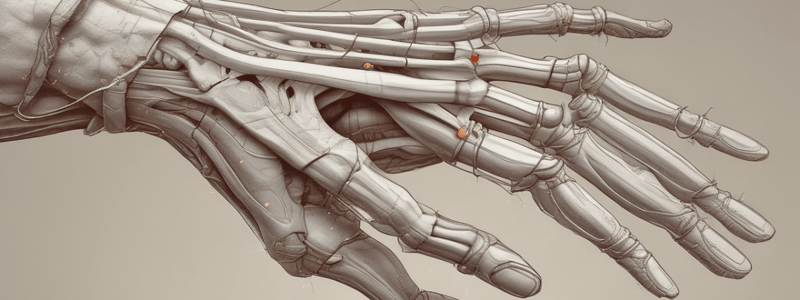Podcast
Questions and Answers
What type of joint is the Trapeziometacarpal joint?
What type of joint is the Trapeziometacarpal joint?
- Saddle joint (correct)
- Hinge joint
- Condyloid joint
- Plane joint
Which ligaments provide stability to the Metacarpophalangeal joints?
Which ligaments provide stability to the Metacarpophalangeal joints?
- Interosseous ligaments
- Dorsal and velar ligaments
- Annular ligaments
- Palmar and collateral ligaments (correct)
What is the main function of the Trapeziometacarpal joint?
What is the main function of the Trapeziometacarpal joint?
- To flex and extend the wrist
- To abduct and adduct the fingers
- To grasp, grip, hold, and manipulate objects (correct)
- To rotate the forearm
What type of joints are the Interphalangeal joints?
What type of joints are the Interphalangeal joints?
What is the movement that occurs at the Intermetacarpal joints?
What is the movement that occurs at the Intermetacarpal joints?
Which of the following joints uses the concave rule for arthrokinematics?
Which of the following joints uses the concave rule for arthrokinematics?
What is the shape of the metacarpal head and the base of the first phalanx in the Metacarpophalangeal joints?
What is the shape of the metacarpal head and the base of the first phalanx in the Metacarpophalangeal joints?
What type of joints are the Carpometacarpal joints?
What type of joints are the Carpometacarpal joints?
What is the reason for the capsule laxity in the Trapeziometacarpal joint?
What is the reason for the capsule laxity in the Trapeziometacarpal joint?
Which of the following joints is responsible for the opposition of the thumb?
Which of the following joints is responsible for the opposition of the thumb?
Flashcards are hidden until you start studying
Study Notes
The Hand
- The hand consists of four types of joints: Carpometacarpal (CMC), Intermetacarpal, Metacarpal-phalangeal, and Interphalangeal.
Carpometacarpal Joint
- The carpometacarpal joint is located between the distal row of carpal bones and the proximal bases of the five metacarpal bones.
- It allows the concavity of the palm to fit around many objects.
- The joint has a capsule and ligaments (dorsal, palmar, and interosseous) that provide stability.
- The joint is classified as a plane joint, with a sling gliding motion, except for the first metacarpal joint or Trapeziometacarpal joint.
Trapeziometacarpal Joint
- The trapeziometacarpal joint is a saddle joint with two main axes of motion (flexion/extension and abduction/adduction + opposition).
- It is located between the trapezium and metacarpal 1.
- The joint has an important function in grasping, gripping, and manipulating objects.
- The close-packed position of the joint is in full opposition.
Osteokinematics and Arthrokinematics
- Osteokinematics refers to the movement of the bones.
- Arthrokinematics refers to the movement of the joint surfaces.
- In the trapeziometacarpal joint, abduction/adduction follows the convex rule, while flexion/extension follows the concave rule.
Trapeziometacarpal Joint Stability
- The trapeziometacarpal joint is subject to high stress loads, particularly during pinch and grasp maneuvers.
- The joint has a wide range of motion due to capsule laxity.
- Ligaments and tendons provide stability to the joint.
Intermetacarpal Joints
- The intermetacarpal joints are located between the bases of the second to fifth metacarpal bones.
- The joints are connected by the dorsal and volar ligaments that pass transversely from one metacarpal to another.
- The intermetacarpal joints provide reinforcement to the carpometacarpal joints.
Metacarpophalangeal Joints
- The metacarpophalangeal joints are located between the metacarpal bones and the proximal phalanges of the fingers.
- The joints are classified as condyloid joints with a convex metacarpal head and a concave base of the first phalanx.
- The joints follow the concave rule in arthrokinematics.
- Stability is provided by the palmar and collateral ligaments, as well as flexors and extensors muscles.
Interphalangeal Joints
- The interphalangeal joints are located between the phalanges of the fingers.
- The joints provide flexion towards the palm of the hand.
- The joints are classified as hinge joints with a flexion/extension motion.
- Stability is provided by the palmar and collateral ligaments, as well as flexors and extensors muscles.
- The joints follow the concave rule in arthrokinematics.
Studying That Suits You
Use AI to generate personalized quizzes and flashcards to suit your learning preferences.



